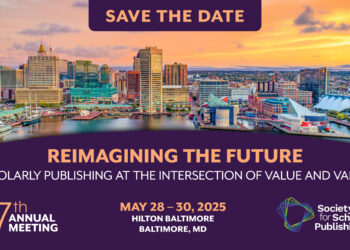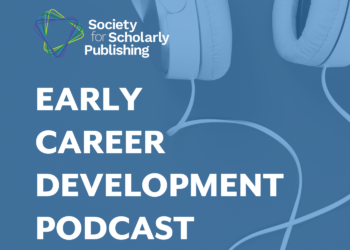
Over the last 4 months, I have attended many of the major publishing conferences and have learned quite a bit about the average attendee. I am going to cut to the chase and say that we publishing professionals are missing out on engaging key audiences.
I was program co-chair for the STM Society Day back in April. For a session on open access, I invited Emilio Bruna, editor of Biotropica and professor in the Department of Wildlife Ecology & Conservation at the University of Florida. I “knew” Emilio from Twitter and sensed that while he thought open access was the ultimate goal, as editor of a small but distinguished journal, he wasn’t sure how to replace the income from subscriptions by going OA.
Emilio gave a great talk but started by saying something very telling. He said that he had learned a lot about the business of publishing and about programs publishers were offering, including Wiley, the publisher partner for his journal, while at the STM meeting. This was the first he was hearing about publisher efforts to extend free or almost free subscriptions to developing countries.
Fast forward to the Council of Science Editors Annual Meeting in May. I invited my friend Jamie Vernon, Director of Science Communications and Publications and Editor-in-Chief of American Scientist at Sigma Xi, to talk about a student journal his organization has launched. Jamie’s passion is science communication.
The session on engaging young students in scientific research was fantastic. During one of the networking breaks later, Jamie said to me, “This is a great meeting. I don’t understand why my friends [in science communication] aren’t here.”
At the Society of Scholarly Publishing meeting in June, I attended a session with early career researchers. After the discussion, one panelist said that he wished he had come to conferences like this when he started researching and writing.
So back to my earlier point—these three meetings, each excellent at attracting publishers, publication managers, and editors, are failing to draw in the very people being served by the industry. Mostly, as in the examples above, a few “outsiders” are invited to speak and if we are lucky, they stay for the whole conference.
This kind of makes sense in that researchers go to their technical conference and science communicators are typically researchers with a side passion. Funds for conference attendance are limited and they rightly choose the meeting most relevant to their day job.
The “sound bites” I took away include:
- Even if authors and editors hear about what publishers are doing every now and again, the info is not sticking. How many times has one of your editors ask that your journal do something that you have been doing for the last 5 years?
- Editors get questions about you as a publisher from their colleagues. They need some basic information to answer those questions on the spot.
- Researchers, especially younger ones, have lots of questions about what happens once they submit a paper. Even before they submit they are wondering what the editor will think, did they format the paper properly, will the reviewers understand what they are trying to convey?
- Science communicators are allies in finding better ways to help researchers tell their stories and yet they are not working collaboratively with journal publishers.
It feels like publishers are missing the boat here. It’s not about telling researchers how best to format a paper or showing new collaborative writing tools. It’s about making the conversation inclusive. No matter what you see on Twitter and in blogs, not one of these communities can chart a course for the future of scholarly communication alone.
I’ve said it before and I’ll keep saying it–there needs to be room for all kinds of business models, access models, even peer review. Shaking things up, talking about improvements, is very exciting and we have seen good things come out of it. That said, there is no one-size-fits-all solution. It does not exist.
We are still stuck with two sides battling for the future of scholarly publishing and it all centers on one topic—open access. The open access advocates, some of them backed by large library groups, are pulling out all the stops to “take down” the traditional publishing establishment. On the other side are the publishers who expect to be compensated for the work they are doing on the finished papers. Both hardcore sides are small. Stuck in this middle are a lot of researchers that are interested in tenure who are not particularly concerned about whether they publish their work in open access journals or not. Also in this space are smaller society publishers that just want to provide the services their authors/members/readers value.
So how long will we stay in this quagmire?
Science communicators may be even worse off. They are screaming into the wind of a dumbed-down global media presence and a society that believes anything they see on Twitter three times. And yet, a group like the Council of Science Editors, of which I am currently the President, has this as their vision: “To be indispensable in the communication of science.” I believe in this vision, and the role publications can play, but how do we achieve this vision if those on the front lines of science communication are not fully engaged in our organization?
Maybe now is the time to bring folks together and see what we can come up with. There are no absolutes. No “it’s my way or the highway” demands. That is not working. There needs to be negotiation, not annihilation. How can we, as a combined ecosystem of smart people, figure out how to do research, disseminate research, and communicate research in a financially sustainable way? Here are some thoughts on how to get there:
- More engagement: librarians, researchers, science communicators, and publishers need to invite each other the table. Maybe this can be done with workshops, joint conferences, or special sessions at each other’s conferences.
- More listening: no one hears anything when people are shouting across the “room.” Stop shouting and be willing to have a conversation. Listen to what each sides needs and what each side has to offer.
- More cross-over: we need to do more than just invite a few folks to speak at publishing meetings—which is already a hard sell. And if we do invite them, make it worth their time to stick around for the entire meeting. We all have a lot to learn from each other.
These distinct groups of people have a lot of cross-over and share similar goals. Not all of the goals are the same but some of them are identical. Let’s see where we match up and what we can work on together.
What do you think? Are there common goals and ways we can work together to meet them? Are there success stories of groups that are already working together to improve the ecosystem?
Discussion
9 Thoughts on "Meeting in the Middle"
Sounds good, but I am unclear who the science communicators are. I would think journal publishers would be among them.
Since the Editor-in-Chief of American Scientist is your friend Angela, you might try to persuade him that the journal, like most other leading journals, should formally declare that it follows the COPE code of publication ethics.
Part of the challenge here, I think, is that front-line staff from publishing companies don’t do a sufficient job of communicating the big picture with partners such as client societies. They do a perfectly good job of organizing data about a specific journal, but they don’t do a great job of putting the performance of the journal or other intellectual property into the context of an evolving industry. As a consultant I spend a lot of effort providing this industry context for my clients, and I can tell you that it often seems to come as a big revelation. This leads me to wonder whether publishing companies themselves — particularly the big ones — do a good enough job of keeping their mid-level/frontline employees fully conversant with overall industry trends.
I share your frustration, Angela. For years I volunteered to be on panels about publishing at scholarly conferences, and inevitably our panels were up against a huge number of other panels in the same time slot and typically we would get maybe 20 people showing up, most of them grad students wanting to know how they could get their dissertations published. Eventually I began insisting that I would not be on such panels unless they were positioned either as plenary sessions or at least at a time when there were not a huge number of competing sessions. One other way, though, of communicating to a lot more scholars is to write articles about publishing for their newsletters, as I have done for the American Political Science Association, for example, in its journal PS and for the Latin American Studies Association’s Forum publication.
Some observations from a skeptic.
1. Authors and editors are primarily scientists and know their science
2. To authors and editors publishing is at best a tertiary concern if not lower
3. Most employees of publishing houses do not know nor are taught about the finances of publishing except on how to fill in a silly spreadsheet which has no meaning.
4. Publishers have a vested interested in keeping finances in a locked box
5. Probably and most importantly, publishers do not want communicators at the table.
2. To authors and editors publishing is at best a tertiary concern if not lower
I’m not sure about editors, but for researchers, this is definitely the case. As publishers, we tend to lose sight of the fact that we are not the center of the researcher’s universe. Publishing is something done on occasion and often with a good deal of annoyance. Reading is something done on the side of one’s real work. So the question of how much time at one’s annual meeting one would be willing to devote to something peripheral is a good one.
4. Publishers have a vested interested in keeping finances in a locked box
For some publishers with high margins and profits, this may indeed be the case. But for others in the not-for-profit realm, transparency can often offset some of the criticisms used to attack all publishers by lumping them all into one group.
I didn’t know publishers asked writers–or readers–anything. I was exposed to cynical realities about publishing several years ago from educators who wanted new things published to use in learning. The chief reality shared was that publishers publish what’s safe, and what’s safe is what had sold in the past and was selling, however well (or not), in the present. Publishing newness–new ideas, new progress, new trends–was therefore not on the publishing table or on the publishers’ shelves as finished works. So in essence, in a back-handed way, scholarship was pushed back for the lack of promotion in the present. Progress was pushed back.
Here, I learn two things that are promising. Publishers are part of the discussion on what’s happening now in scientific disciplines. Not only do publishers come to the table but they also sometimes make the table by creating the program opportunity for dialogue and discovery. The other promising thing I learned is that published material is offered to developing nations and communities for free or nearly free. We are going to be a global entity of discovery, progress, and promulgation of ideas and invention. We should be this entity now and teach it–have it learned–for the future.
Let’s keep these promising things–these paths, these routes, and the means to make them–built in the present and molded like new highway lanes (but without a fixed direction, necessarily) for the future.
I’m sorry, who am I but an educator semi-retired through disability. As such (semi-retired through disability), I have the opportunity to reflect, whether or not I like to. And I like to. Reflect.
Thank you, Angela Cochran, for this wonderfully evocative writing.
It would be remiss not to remind people of Advancing Research Communication and Scholarship which was a blog post curated by Alice Meadows from March 2015: http://scholarlykitchen.sspnet.org/2015/03/11/advancing-research-communication-scholarship-an-interview-with-robin-champieux-and-jill-emery-about-this-new-conference/
This event ended up being very successful for a first year event with over 200 attendees from a wide swath of disciplines in addition to publishers and librarians. We were able to obtain such a fantastic mix of attendees in part due to directed invitation and through a scholarship program we ran for early career researchers/scholars that provided travel funding to multiple people to attend the event. As noted above, for these events to be successful the incentive and level of engagement has to be balanced to accommodate our colleagues invested in careers in academia and science.With ARCS inaugural year, that balance was achieved through careful attention to insuring our program was not swayed by any single constituency. This translated to bigger panels and longer time frames for panel discussions.
We will be holding a funded competition geared towards early career researchers and scholars in the near future and are starting to develop our next event for Fall 2016. We invite all interested parties to review the conference program from 2015 and provide us with input as we go forward.
Good point, Jill. ARCS, FORCE 11 and I’m sure others are trying to create fora in which researchers and scholars are better represented in discussions with publishers and institutions around scholarly/ research communications issues. Rich’s point above is also a good one – no organisation can send everyone to such events, but it’s almost impossible for those who do go to truly convey to their less fortunate colleagues the ideas, the experience, the visceral sense of belonging and having a role to play, that comes from face-to-face interaction and immersion. I attribute much of my knowledge and relationships to having been able to attend events like UKSG from a very early stage of my career, but my attempts at documenting what I have learned at such events (from liveblogging and tweeting to writing reports and articles) is a pale echo of the multi-dimensional reality.
Perhaps all such organisations (SSP too!) could provide more scholarships / bursaries etc to enable more “front-line” people to experience the cross-stakeholder discussions etc that will inspire that interest in and engagement with the “bigger picture”.


